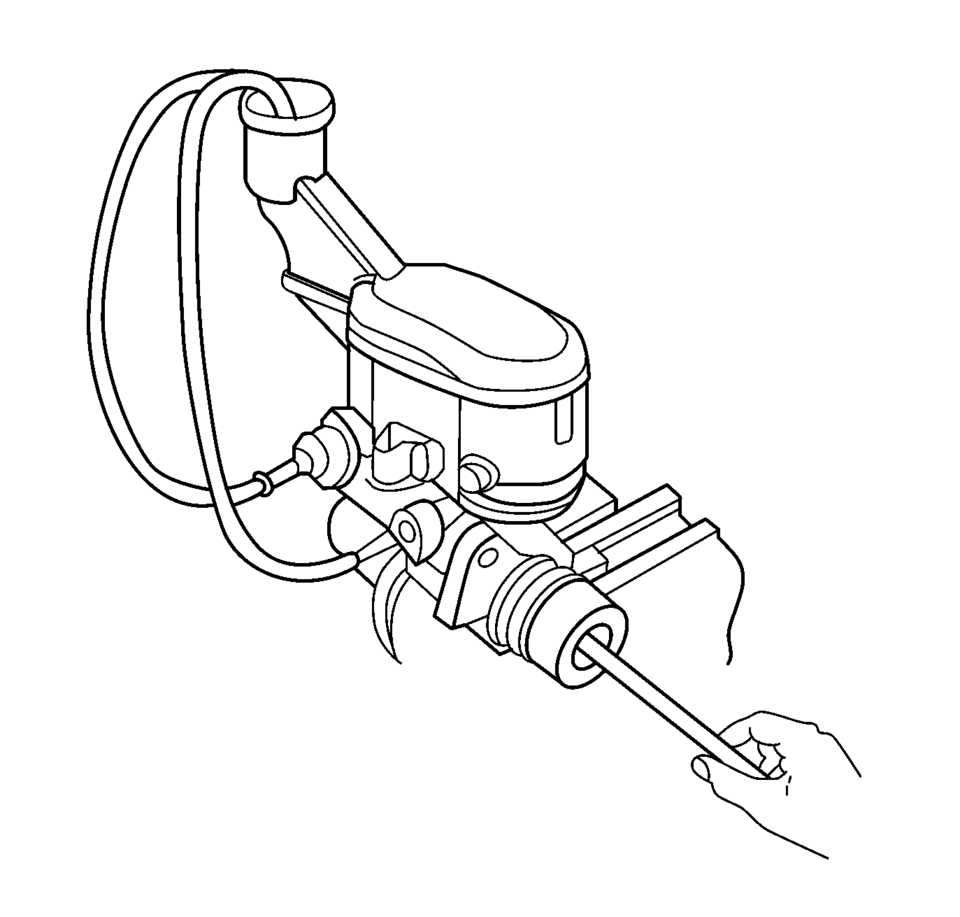Chevrolet Sonic Repair Manual: Master Cylinder Bench Bleeding
- Secure the mounting flange of the brake master cylinder in a bench vice so that the rear of the primary piston is accessible.
- Remove the master cylinder reservoir cap and diaphragm.
- Install suitable fittings to the master cylinder ports that match the type of flare seat required and also provide for hose attachment.
- Install transparent hoses to the fittings installed to the master cylinder ports, then route the hoses into the master cylinder reservoir.
- Fill the master cylinder reservoir to the maximum fill level with brake fluid from a clean, sealed brake fluid container. Refer to Master Cylinder Reservoir Filling.
- Ensure that the ends of the transparent hoses running into the master cylinder reservoir are fully submerged in the brake fluid.
- Using a smooth, round-ended tool, depress and release the primary piston
as far as it will travel, a depth of about 25 mm (1 in), several times. Observe
the flow of fluid coming from the ports.
As air is bled from the primary and secondary pistons, the effort required to depress the primary piston will increase and the amount of travel will decrease.
- Continue to depress and release the primary piston until fluid flows freely from the ports with no evidence of air bubbles.
- Remove the transparent hoses from the master cylinder reservoir.
- Install the master cylinder reservoir cap and diaphragm.
- Remove the fittings with the transparent hoses from the master cylinder ports. Wrap the master cylinder with a clean shop cloth to prevent brake fluid spills.
- Remove the master cylinder from the vice.

Warning:
Refer to Brake Fluid Irritant Warning.
Caution:
Refer to Brake Fluid Effects on Paint and Electrical Components Caution.
 Brake Warning System Description and Operation
Brake Warning System Description and Operation
Brake Warning Indicator
Brake Warning Block Diagram
B80Park
Brake
SwitchB20Brake
Fluid Level
SwitchK9Body
Control
ModuleP16Inst ...
 Master Cylinder Replacement
Master Cylinder Replacement
Removal Procedure
Warning: Refer to Brake Fluid Irritant Warning.
Caution: Refer to Brake Fluid Effects on Paint and Electrical
Components Caution.
Place the ignit ...
Other materials:
Engine Compartment Overview
1.4L L4 Engine
1. Engine Air Cleaner/Filter.
2. Engine Oil Dipstick. See Engine Oil.
3. Engine Cooling Fan (Out of View). See Cooling System.
4. Engine Oil Fill Cap. See Engine Oil.
5. Engine Coolant Surge Tank and Pressure Cap. See Cooling System.
6. Brake/Clutch Fluid Reservoir. See Brakes ...
Rear Side Door Window Outer Sealing Strip Replacement (Hatchback)
Rear Side Door Window Outer Sealing Strip Replacement
Callout
Component Name
1
Rear Side Door Window Outer Sealing Strip Screw
Caution: Refer to Fastener Caution.
Tighten
2?€‰Y (18?€‰lb?€‰i ...
Power Windows Description and Operation
Power Window System Components
The power window system consists of the following components:
Driver window switch
Front passenger window switch
Left rear window switch
Right rear window switch
Window regulator motors in each of the doors
Body control module
...
0.0056
